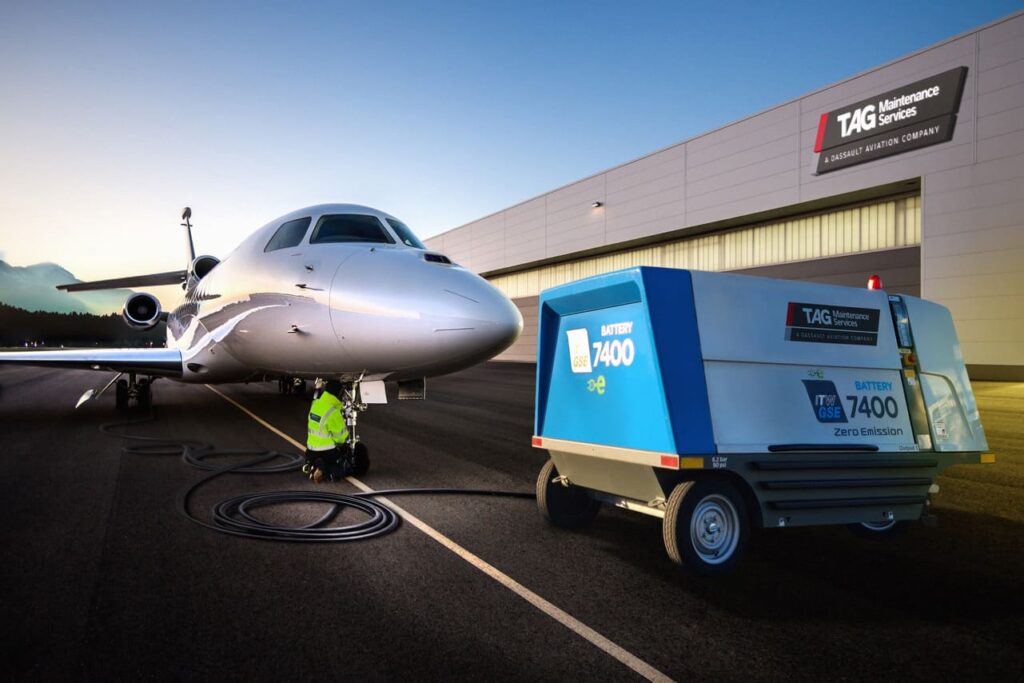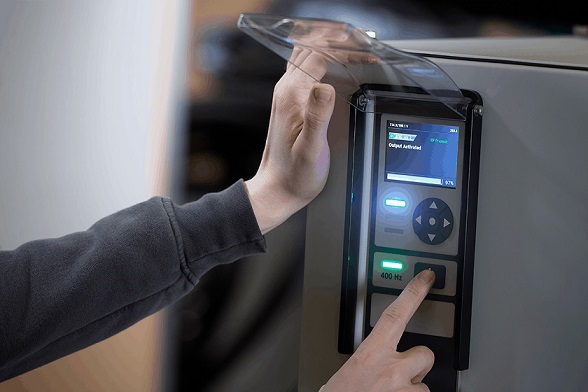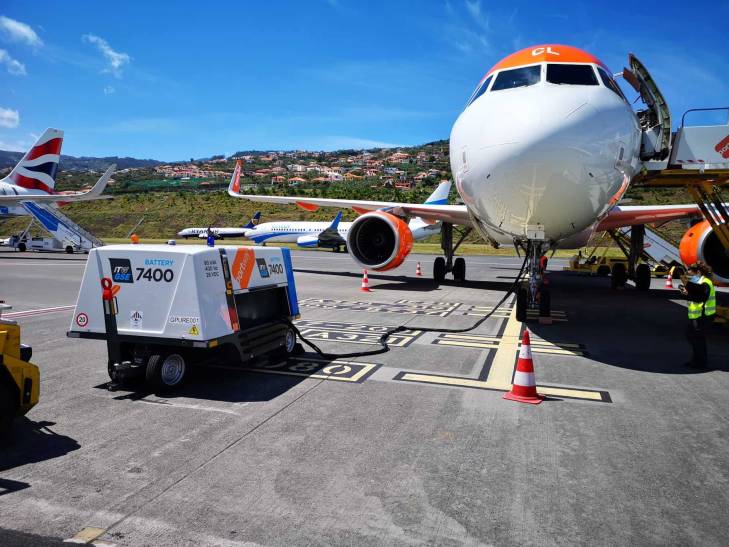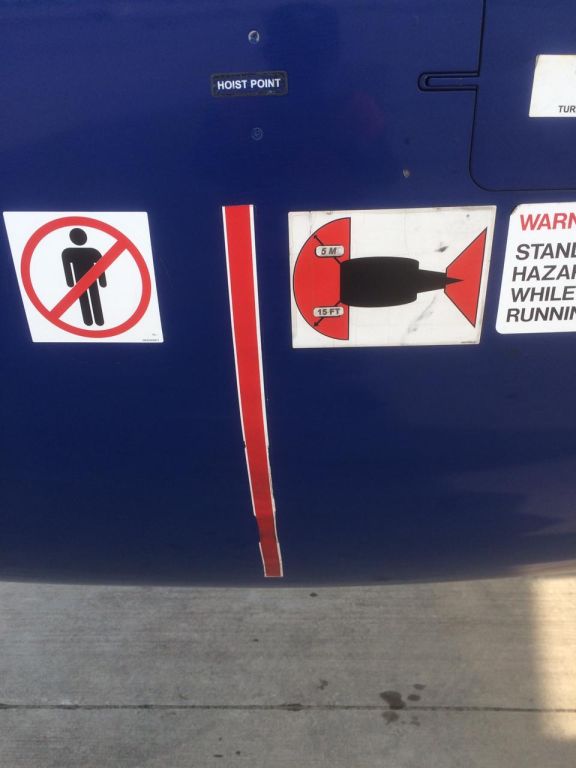After an aircraft is parked on the ramp (aircraft stand), the very first ground support operation is connection of Aircraft Ground Power Unit (GPU or AGPU) with the aircraft. Today’s article explains the ramp safety aspects associated with operation of aircraft ground power unit.
We have a dedicated article on AGPU that discusses it in detail, therefore, we will not go into explaining what it is in this article. This article is focused on explaining only the ramp safety aspects in its operation.
However, as a brief introduction, when an aircraft is parked on the ramp, it needs electrical power from ground to keep its internal electrical systems running. This is accomplished through a piece of equipment known as an aircraft ground power unit (GPU or AGPU). It is connected through a cable that runs from the ground power unit to the aircraft and an electrical adapter is plugged into the aircraft electrical power receptacle.

So now that we have had the introduction, let’s dive right into the heart of the topic.
Earthing of GPU Critical for Ramp Safety
Aircraft Ground Power Unit (GPU or AGPU) is an electrical equipment. The first and foremost safety aspect in its operation arises before the flight arrives and before any operation is performed. Proper electrical earthing of ground power equipment is critical for safety of personnel operating it as well as safety of the aircraft and the unit itself. It is of utmost importance for preventing any mishap on the ramp involving ground power.
All modern aircraft ground power units come installed with an electronic control system that automatically displays an error or alarm message if there is any problem in earthing of equipment. However, such an intimation from the equipment requires someone to read it by engaging with its Human Machine Interface. It is generally not an audible alarm to inherently draw attention towards itself.
In view of above, it becomes necessary that aircraft ground power operators check the display interface of the machine as part of their preflight inspection of ground support equipment (GSE). However, maintaining the reliability of this electrical earthing is the primary responsibility of maintenance team.
Airline, ground handling company or airport, whoever is the owner of the aircraft ground power unit must have a maintenance program to be executed by trained technicians. Within that program, periodic inspection of the ground power unit’s earthing is supposed to be present for ensuring safety in its operation.

Safety in Handling Aircraft Ground Power Cable
Ground power cables and adapters are designed for withstanding the rough tarmac and apron conditions including wear and tear by getting dragged on the ramp (or aircraft stand). Their operation involves unrolling and laying the cable during connection and rolling it after disconnection.
It involves a lot of physical handling of the cable which has two main safety aspects associated with it.
First, due to the strength of cable insulation (for bearing wear and tear of physical handling), aircraft ground power cables are heavy. Moreover, it gets rough to the touch as it is used on the ramp over its life. Handling the cable with bare hands is likely to cause skin abrasion. Therefore, safety gloves are necessary for aircraft ground power personnel.
Secondly, aircraft ground power operation is performed even when it’s snowing or raining on the airport. It means that cable will have to be handled and connected with the aircraft even under wet conditions. If the wear and tear on the ramp has exposed any conductor part of the cable, it becomes an electrical hazard that is not like common electrical hazards. It is so because damage to ground power cable insulation is not easily identified because ground power personnel don’t undertake complete cable inspection before operation.
Therefore, the safety gloves of ground power personnel must offer protection from electrical shock as well and not just from skin abrasion. At the same time, it is the duty of maintenance team to periodically inspect the ground power cable for any damage or wear of insulation of the cable. In case any wearing is found, it must be professionally reinsulated for ensuring safety in ground power operation.
Apart from the safety associated with physical handling of the cable by ground power personnel, there is another important safety aspect in aircraft ground power operation. Since ground power cable lays on ground on a busy ramp where movement of a lot of other vehicles and ground support equipment (GSE) is taking place, there is risk of ground power cable getting runover by some other vehicle or machine.
The above hazard is mitigated at two levels. First, the color of aircraft ground power cables is often kept bright like yellow or red by many manufacturers to improve its visibility on the busy ramp. However, it is not a mandatory practice in industry as you’d easily find many manufacturers having cables of black color.
Therefore, when ground power personnel connect the cable, they have to carefully position the ground power unit and lay the cable through the shortest possible route. It is a simple and seemingly obvious step, however, it contributes towards reducing risk of cable runover.

Finally, the above referred hazard (of cable runover) has another solution also. It is a Utility Pit System. It is simply an underground setup to bring the point of connection of aircraft ground power close to the aircraft receptacle in order to reduce the distance in which GPU is positioned and its cable is laid.
It reduces chances of collision of any other ground support equipment (GSE) with GPU while also reducing risk of GPU cable runover. It does that by offering aircraft ground power connection nearest to the aircraft. The cable length from pit to aircraft is always less than if a mobile GPU or a bridge mounted GPU is being used on the ramp.

Aircraft Engine Ingestion Hazard in Aircraft Ground Power Operation
Another safety risk associated with aircraft ground power operation is that GPU is the only piece of equipment that is connected with the aircraft while its engine may still be running. That is so because pilots need to have a substitute source of electrical power before the primary source (the jet engine) is turned off.
The preferable procedure for ramp safety is to turn the aircraft engines off and shift the power to Auxiliary Power Unit (APU) of the aircraft when the aircraft parks on the ramp. While there are general guidelines about not approaching near the aircraft while its engines are running, a directive specifically addressed to GPU operation with engines running cannot be traced in literature of international regulatory bodies such as International Civil Aviation Organization (ICAO). Therefore, such specific instructions may or may not be present through the respective national or local authorities.

United Kingdom’s Health and Safety Executive (the national regulator on health and safety in UK’s industry) issued a special letter to industry highlighting the matter of connecting GPU while engines were running which is a great example of the subject issue being focused and addressed in great detail. Some excerpts from the letter are reproduced as under:
“In May 2008 HSE wrote an open letter to the industry outlining our concerns about the emerging practice of routinely connecting Ground Power Units (GPU) to aircraft while the aircraft engines are still running, and the anti-collision lights on…”
“Where the basic rule of not approaching an aircraft with engines running and anti-coll lights on cannot be applied in foreseeable emergency or non-standard situations (such as with an inop APU on an arriving aircraft), the procedures should be risk assessed and clearly documented.”
“…it is HSE’s view that allowing routine approach to aircraft with engines running, with varying procedures, introduces significant additional risks to workers on the ramp, and should not be the procedure of choice“
“Training and supervision will always form the lowest level in any hierarchy of risk control and it is therefore extremely unlikely that a suitable and sufficient risk assessment will result in a system of work which relies on training, competence and supervision alone, where other means are available to reduce the risk i.e. switching engines off.”
– Letter addressed to all aerodrome/airport operators, airlines and airport service providers/ground handlers dated 01st February 2011 by Operational Strategy Division, Health and Safety Executive (HSE), United Kingdom
However, the matter is not addressed by all aviation authorities around the world like the example above. In the absence of any regulation over the issue by the respective authority, aircraft ground power personnel will be connecting GPU while the aircraft engines are still running.
Due to above reason, ground power personnel have to remain cautious of the fact that the jet engine is running and its ingestion danger zone is active. This factor is more important for utility pit systems we discussed above that are installed close to the aircraft body and may fall near the engine.
Adverse weather conditions increase the above-mentioned risk even more. During rain, apron becomes slippery and risk of ground power personnel slipping while handling GPU cable increases. Similarly, during high wind speeds, a running engine that is already sucking air becomes significantly more hazardous for personnel around it.
…if surface winds are gusty and greater than 25 knots, the dimensions defining the inlet hazard zone boundary should be increased by 20 percent.
– AERO magazine, a publication by Boeing Commercial Airplanes – ‘Preventing Engine Ingestion Injuries When Working Near Airplanes’ by Fred Zimmer, Lead Engineer, Service Engineering, Propulsion
In view of above discussion, it is preferable to follow the policy adopted by HSE UK regarding extinguishing aircraft engines before any person is allowed to approach the aircraft. However, in the absence of such a policy, it is important to realize that aircraft ground power personnel needs to be imparted special training for operating GPU by approaching the aircraft with running engines.
While the matter may appear small at first owing to being associated with a brief operation on the aircraft stand, it is a critical safety issue from the perspective of ramp safety.
Safety in Aircraft Ground Power Operation on Widebody Aircrafts
Another important factor in ramp safety during aircraft ground power operation is associated with connecting power with widebody (or double isle) aircrafts. Generally, the ground power receptacle of widebody aircrafts is more than 7 feet above ground. Therefore, ground power personnel cannot reach the receptacle without a ladder.

For all GPU connections with widebody aircrafts, ground power personnel carry a ladder with themselves to the ramp and use the ladder to reach the aircraft’s power receptacle for plugging in the power receptacle. The use of ladder carries with itself certain safety considerations.
First and foremost, the ladder used in aircraft stand operations must be robust. While this point is seemingly simple, the hazard associated with a poor quality ladder is significant. In case of failure, the operator will probably grab hold of something he is not supposed to grab, such as the aircraft’s ground power receptacle cover, and could damage some aircraft part along with injuring himself.
Secondly, a team of two operators is preferred whenever GPU is to be connected to a widebody aircraft because a single operator will have to climb the ladder with the ground power connector and cable on his/her shoulder which involves risk of accident and injury. Teamwork mitigates this risk and makes the operation safer.
Finally, operators must observe caution in bad weather conditions involving rain, snow or high wind speed due to obvious reasons that can easily be imagined keeping in view the dynamics of GPU operation discussed above.
So in order to ensure ramp safety during aircraft ground power operation, GPU operation personnel, maintenance teams and regulatory bodies have to play a collective role in addressing safety factors relevant to their domains.
If you are interested in obtaining a base level knowledge about ramp safety, check out this 7-hour video based course on Udemy that you can easily finish in a week (or binge watch in a day or two). It explains ramp safety in detail with interesting case studies of ramp accidents for in-depth understanding of the subject. It also explains ramp safety aspects associated with 13 main ground handling operations carried out on the ramp.